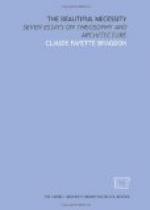Such being the relation between them, the difference in the nature of the ideas bodied forth in music and in architecture becomes apparent. Music is interior, abstract, subjective, speaking directly to the soul in a simple and universal language whose meaning is made personal and particular in the breast of each listener: “Music alone of all the arts,” says Balzac, “has power to make us live within ourselves.” A work of architecture is the exact opposite of this: existing principally and primarily for the uses of the body, it is like the body a concrete organism, attaining to esthetic expression only in the reconciliation and fulfilment of many conflicting practical requirements. Music is pure beauty, the voice of the unfettered and perpetually vanishing soul of things; architecture is that soul imprisoned in a form, become subject to the law of causality, beaten upon by the elements, at war with gravity, the slave of man. One is the Ariel of the arts; the other, Caliban.
Coming now to the consideration of architecture in its historical rather than its philosophical aspect, it will be shown how certain theosophical concepts are applicable here. Of these none is more familiar and none more fundamental than the idea of reincarnation. By reincarnation more than mere physical re-birth is meant, for physical re-birth is but a single manifestation of that universal law of alternation of state, of animation of vehicles, and progression through related planes, in accordance with which all things move, and as it were make music—each cycle complete, yet part of a larger cycle, the incarnate monad passing through correlated changes, carrying along and bringing into manifestation in each successive arc of the spiral the experience accumulated in all preceding states, and at the same time unfolding that power of the Self peculiar to the plane in which it is momentarily manifesting.
This law finds exemplification in the history of architecture in the orderly flow of the building impulse from one nation and one country to a different nation and a different country: its new vehicle of manifestation; also in the continuity and increasing complexity of the development of that impulse in manifestation; each “incarnation” summarizing all those which have gone before, and adding some new factor peculiar to itself alone; each being a growth, a life, with periods corresponding to childhood, youth, maturity and decadence; each also typifying in its entirety some single one of these life-periods, and revealing some special aspect or power of the Self.
For the sake of clearness and brevity the consideration of only one of several architectural evolutions will be attempted: that which, arising in the north of Africa, spread to southern Europe, thence to the northwest of Europe and to England—the architecture, in short, of the so-called civilized world.




